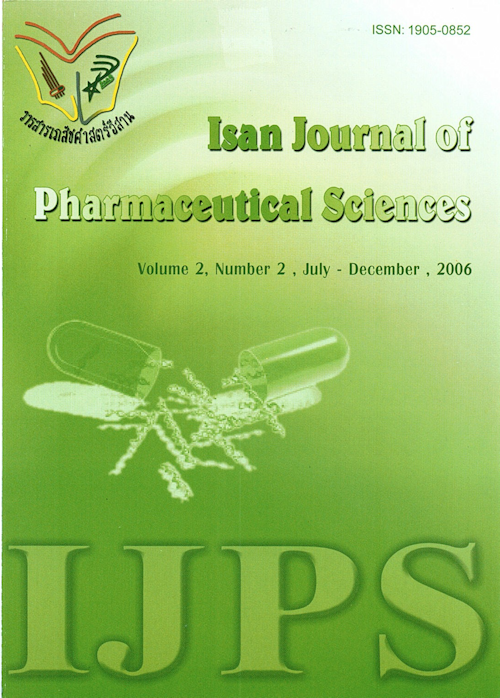Study of The Extraction Method for Chloramphenicol Residues in Chicken Samples by Solid-phase Extraction and Solvent Extraction
Main Article Content
Abstract
Chloramphenicol is a broad-spectrum antibiotic which have a strictly regulation for importation and is not allowed to feed the animals for consumption in Thailand because of the toxicity in humans. The purpose of this study was to determine the appropriate extraction method to detect the chloramphenical residue in chicken samples. Solid-phase and liquid extraction were used in this study. To detect chloramphenicol, high performance liquid chromatographic method combined with ultraviolet-visible detector was used. From the result of this study, it could be concluded that the combination of solid-phase extraction and liquid extraction was appropriate and gave a good result for detecting the chloramphenicol residue in chicken. The method showed significantly reduce the interference from endogeneous substances. All 24 chicken samples collected from the markets in Muang district, Khon Kaen province, were not found chloramphenicol residue.
Article Details
In the case that some parts are used by others The author must Confirm that obtaining permission to use some of the original authors. And must attach evidence That the permission has been included
References
Burg at V, Delatour p and Rico AG. (1981). Bound residues of veterinary drugs. Ann Rev Vet., 13(3), pp. 277-289.
Cooper AD, Tarbin JA, Farrington WH and Shearer G. (1998). Aspects of extraction, spiking and distribution in the determination of incurred residues of chloramphenicol in animal tissues. Food Add. & Cont, 15(6), pp. 637-644.
Epstein RL. (1994). International validation study for the determination of chloramphenicol in bovine muscle. J. AOAC. Int. 77(3), pp. 570-576.
Kolosova Al, Samsonova zv, Egorov AM, Sheveleva SA, Orlova NG, Kiseleva TV, Khotimchcnko, SA and Tutelian VA. (1999). Optimization of a method of solid-phase immunoenzyme analysis for determination of chloramphenicol in milk. Vop. Pita., 68(1), pp. 23-27.
Martindale: The Complete Drug Reference. (1999). USA: Pharmaceutical Press, pp. 182-184.
National Office of Animal Health. (2003). The advisory committee on the microbiological safety of food report on: - Antibiotic resistance and food safety. United Kingdom.
Pfenning, AP, Madson MR, Roybal JE, Turnepseed SB, Gonzales SA, Hurlbut JA and Salmon GD. (1998). Simultaneous determination of chloramphenicol, florfenicol and thiamphenicol residues in milk by gas chromatography with electron capture detection. J. AOAC. Int., 81(4), pp.714-720.
Pfenning AP, Roybal JE, Rupp HS, Turnepseed SB, Gonzales SA and Hurlbut JA. (2000). Simultaneous determination of residues of chloramphenicol, florfenicol and thiamphenieol in shrimp tissue by gas chromatography with electron capture detection. J. AOAC. Int., 83(1), pp. 26-30.
World Health Organization. (2001). Monitoring antimicrobial usage in food animals for the production of human health, WHO consultation.


